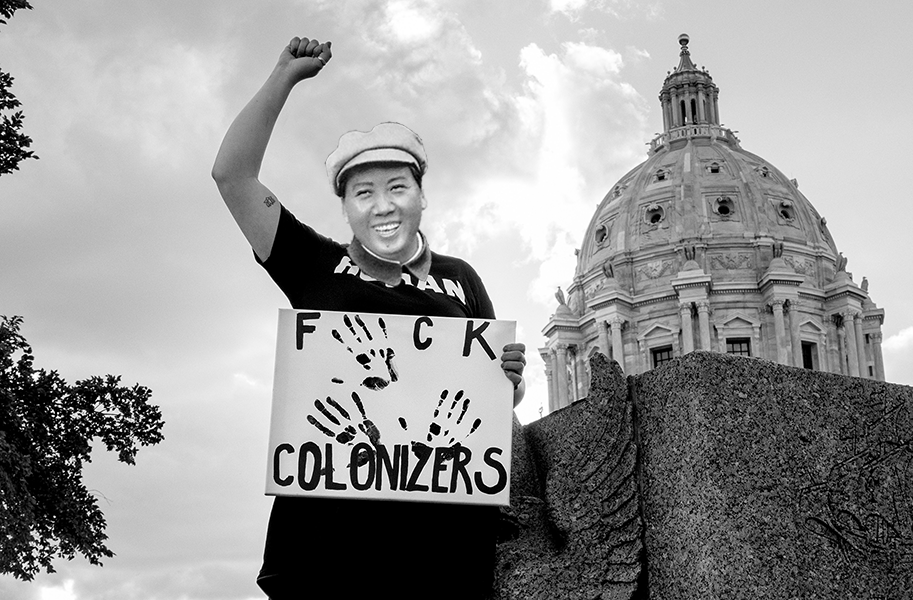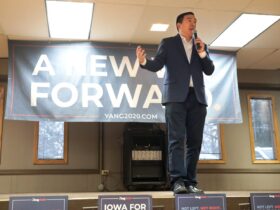The protest movements that have upended American life following the death of George Floyd have stupefied both pundits and ordinary citizens. In some ways, what we are witnessing is unique. But it is useful to compare this civic upheaval to another one, the Chinese Cultural Revolution that began in 1966. Though the ideologies and social context of the two movements differ, the class forces driving them are similar, and a close read of those forces can help illuminate the character and possible destinations for this kind of politics.
The class nature of the Chinese Cultural Revolution
The Cultural Revolution was arguably the second great catastrophe of the People’s Republic of China. It took place in the immediate backdrop of its first great catastrophe, the Great Leap Forward, Chairman Mao Zedong’s badly mismanaged attempt to rapidly industrialize a largely agrarian society, which produced the greatest famine in human history and killed tens of millions of people. In the fallout, Mao’s status within the Chinese Communist Party was reduced to a more ceremonial role, making Liu Shaoqi and Deng Xiaoping the President and General Secretary of the Secretariat, respectively. Though formally diminished, Mao’s influence remained significant as the founder of the state and Party Chairman.
However, by the end of the Cultural Revolution Mao had returned to a position of de facto ultimate authority and his critics within the Party were either expelled or politically neutralized. It was not a “revolution” in the sense of overturning an existing order to establish a new one, but rather the return and reinforcement of a once-demoted regime.
It was not a “revolution” in the sense of replacing an existing order with a new one, but rather the return of a once-demoted regime.
The Cultural Revolution famously depended on college students and the Red Guards. The Red Guards began as an independent but politically-interested group of university students who supported a broadly Maoist cultural agenda. The formal alliance between Mao and the student movement began at Peking University with professor Nie Yuanzi, at the time a 45-year-old Party member in the Department of Philosophy. Nie vocally supported Mao’s removal of the mayor of Beijing and linked this to the struggle to remove bourgeois and capitalist elements from university administration. Once Mao officially blessed her statement, students began to organize and revolt against party authorities in universities across China. In this way, a political alliance was formed between the recently disempowered elite and educated youth and middle-class academics.
After the Red Guards had received official support, they expanded beyond their original constituency of university students to encompass high school students and more lower class youth generally. They took control of universities and engaged in purges and violence throughout the country. The army and police did not significantly interfere for the better part of two years, as the Red Guards were officially sanctioned by elements of the national government. Party journalist Chen Joda lended a raison d’être to the Red Guards, the abolition of the “Four Olds”: old customs, old culture, old habits, and old ideas. None of these were well-defined, but the elasticity was the point. During the time in which this paramilitary group operated, art, temples, and religious icons were destroyed, cemeteries were desecrated, and university professors and intellectuals were persecuted or killed. Most universities were closed for several years, and it arguably took decades for China’s higher education system to recover.
“Struggle sessions” dominated much of middle-class life in this period. People would be accused by Red Guards of anticommunist thought or action, adherence to one of the hated Olds, and subjected to intense questioning and forced confessions. These confessions, whether genuine or strategic, were no guarantee of safety: one might be kept for a period of repentance and hard labor, then later beaten or killed anyway. Once the paramilitary movement spilled out of universities, it targeted party headquarters and bureaucratic offices. The youth wing of the revolution became a para-governmental enforcement arm of the elite class (explicitly, Mao). This class alignment produced an inevitable outcome: the targets of this “revolution” were not the uppermost elites, but middle management, bureaucrats, and systems of social control that intermediated between elites and the populace.
The Red Guards were eventually disbanded and suppressed by the government and the People’s Liberation Army. Despite occasional and even significant Red Guard-PLA clashes, the military was never replaced as the ultimate power in the country. Many of the eager young ex-Red Guards were sent into the countryside on an extended mission of spreading Maoist thought, far away from the centers of power and where they could do less damage, Nie Yuanzi, the Peking University professor who began the movement, among them. In a way, the Red Guards had served their purpose: the middle management of the country was properly chastened and afraid of their elite masters. The bureaucracies that mediated between elites and ordinary people were either in tatters or so cowed as to make direct control frictionless. In sum, an alliance between a disempowered elite and a mostly-young and educated lower-middle class (using the still lower-class youth as enforcers) upended the middle section of society’s bureaucracy, to long-lasting effect.
The character of modern social movements
The class forces of the Cultural Revolution were wielded by Mao in a bid to return himself to power. The class alliance we see in the civil unrest today is similar, but without a central leader or organization. In fact, it is hard to say who the leaders of Black Lives Matter are. The movement, such as it is, was begun as a twitter hashtag by Alicia Garza, Patrisse Cullors, and Opal Tometi. Yet none of these women have been visibly present in the current protests, nor have they been active in directing protests toward any particular goal. Ms. Garza has said that she is not interested in “policing who is and who isn’t part of the movement,” and also that, “we don’t control the movement.”
Over the years a number of groups have proposed various policy goals for BLM and have debated its efficacy (going back years). Critics and counter-critics alike have found themselves carving this or that section of the movement to try and lead, but any island of leadership never lasts long.
Leaderless movements have not yet been capable of restructuring political economies, but they have influenced how societies manage their populations.
The Civil Rights Movement could hardly have been more different. The individual leadership from Martin Luther King Jr., Malcolm X, A. Philip Randolph, and the organizational leadership of the National Association for the Advancement of Colored People, the Southern Christian Leadership Council, and the Congress of Racial Equality lent both structure and strategy to the national movement.
But something in the fabric of society has changed between then and now. Among the many leaderless movements of the modern era–BLM, Tahrir Square, the yellow vests, the Hong Kong protests, and more–social media has played a central role. Once upon a time it took a list of names and activists physically going door-to-door to amass people in, say, Zuccotti Park. Such limitations forced the formation of organizational structures and individual leaders. But now it is possible to create mass events before developing any such organization. In fact, such a structure can be a liability, slowing response time and leaving formal organizations vulnerable to rapidly assembled social media counterevents.
These fluid, leaderless movements have not yet been very capable of restructuring political economies, but they have had and will continue to influence how societies manage their populations. The Egyptian revolution is probably the most powerful example, where two presidents may have been ousted, but military rule over the country is just as entrenched as it was before.
A Cultural Revolution without a Mao
It has been two months since the nation erupted in protests and riots following the death of George Floyd at the hands of law enforcement. In that time, the movement has spread beyond its initial motivating incident. Chicago experienced its deadliest day on record, prompting fear and alarm from city officials. A portion of the city of Seattle was abandoned by police to protesters, who established a form of alternate society where several young people were shot and killed within a month. In Portland, a battle continues to rage over a federal courthouse. The police have withdrawn from some sectors of society, leaving people to plaintively put up signs “Black owned business” and “children sleep here,” hoping the mob will pass them by. Across the country, businesses are shuttered and long stretches of American cities have been destroyed. Even if the movement began that way, these actions cannot be described honestly as protests over police brutality, despite staggering popular agreement on the injustice of the inciting incident. These are, rather, revolts against the government.
Meanwhile, public monuments have been removed or defaced by protesters—from the toppling of statues of confederate general Robert E. Lee, to the beheading of Christopher Columbus, and even the dismemberment of the statue of an immigrant abolitionist who died fighting for the Union. Preempting any similar action, the American Museum of Natural History in New York City is voluntarily removing its statue of a horse-mounted Teddy Roosevelt flanked by a Native American and African man. Not even the great emancipator is spared: the Emancipation Memorial in Washington D.C. has become a flashpoint, with proposals for its removal, while a copy of the statue in Boston is now officially slated for removal.
It is possible to construct a narrative around racial injustice if one only pays selective attention—after all, it is hard to muster up a moral defense for Christopher Columbus or the Confederacy. However, these targets exist alongside Abraham Lincoln, Francis Scott Key, and various religious statues. Something strange is at play when both monuments to the Confederacy and to the emancipation of America’s slaves by the Union are under equal threat. That is, unless one considers what unites them: they are both public testaments to an old regime.
Beyond the struggle over public symbols, elite institutions have also been overturned. The New York Times was witness to an internal coup. The NLRB has loosened regulations on firings (to combat racism). A bevy of unorthodox employees (or merely those perceived as unorthodox) have been fired, including one data analyst who published research arguing that non-violent protests in the Civil Rights era were more effective than violent protests. Many academic, upper class, and government workplaces have held mandatory racial sensitivity trainings, sometimes segregated by race. For the managerial class this movement has ushered in a changing of the guard and a new set of (constantly-shifting) rules.
These events parallel the chaos and class character of the Chinese Revolution, but without a clear elite figure whose interests the chaos serves: that is, without a Mao. It’s worth noting then that tech and retail corporations were among the first to vocally support the BLM protests-cum-riots. While the first fires were being lit in Minneapolis/St Paul, corporations were tweeting their support of the movement, and releasing public statements. Amazon, Microsoft, and IBM announced they would discontinue services to American police forces (not ruling out other state forces, domestic and foreign), while other companies made Juneteenth a paid holiday. All this has occured at the same time as massive layoffs due to the coronavirus economy, coupled by an expansion in corporate ability to fire people.
Why would corporations support this movement, and why these corporations in particular? While President Trump has not had many keystone achievements, his presidency has frustrated the interests of certain economic sectors. The Trans-Pacific Partnership was scuttled as a result of the 2016 election, and Trump’s tariffs and trade war have harmed profits for many American businesses, even drawing the ire of Apple, the world’s largest corporation by market cap. Corporations like Apple operate under a business model that relies on cheap manufacturing labor, primarily in China, and a large external market, primarily in America. Businesses operating under this model have had their profits decline under Trump’s tariffs. For these corporations, this revolution is more about returning transnational capital to a place of unquestioned primacy than it is about protesting the abuses of police power. If Trump can be cowed (or better still—removed), then his policies that have ever-so-slightly slowed capital accumulation in the tech and retail sectors (which have become deeply intertwined) can be reversed. Occasionally, this alliance is elevated from subtext into text: Upon disbanding, some members of the Seattle CHAZ/CHOP anarchist zone called for the revolution to continue by electing Joe Biden, a strange plea if read literally (police abolitionists asking us to elect the author of the 1994 Crime Bill), but entirely intelligible as one sector of class society trying to reinstall an elite class as their patrons.
Capital is our Mao; it is the disempowered regime leaping at the opportunity afforded by the middle and lower-class youth revolt.
Capital, then, is our Mao; these sectors of capital are the disempowered regime leaping at the opportunity afforded by the middle and lower-class youth revolt. They wish to return to a position where they can make decisions unfettered by even mild rebukes to their interests (here in the form of tariffs), and the educated but stagnant middle class want to improve their own position by toppling bureaucrats above them in the hierarchy. In other words: antiracism and police abolition for the managerial and lower classes, free markets and unimpeded supply chains for the corporate boardrooms.
From formation to aftermath
The American Cultural Revolution is a movement that looks like it has come from nowhere, but it began in academia, where it has been fomenting for some time. A professor in Seattle was already subjected, over the course of six months, to struggle sessions by students and a formal investigation into his public opinions on a ballot initiative. The managers and institutions that have crafted the new cultural orthodoxy are currently in such a state of ascendance (backed as they are by capital) that they feel no need to hide their ambitions. Nikole Hannah Jones recently admitted that her Pulitzer-winning New York Times’s 1619 Project is not factual history, but rather always intended to be propaganda. If one cares about the integrity of history this is a travesty, but if one’s goal is creating a movement to chasten the educated middle class and reinstall a class of elite patrons, then this is fine.
The upcoming presidential election offers no off-ramp here: Trump does not have a policy agenda so much as a series of instincts, most of which are directed toward his own self-aggrandizement. Biden on the other hand, in his current state of cognitive decline, will merely be the face worn by the forces of capital within the now-unambiguous party of the rich, the Democratic Party.
As in China, once this union of elites and the upward-looking managerial class wins the cultural revolution, its dogmas will become enshrined in the functioning of the state. Capital could hardly ask for a more fitting ideology for working class exploitation than the woke/BLM theory that has been developing for the past decade: that society is just and good so long as people are materially deprived at racially equivalent rates. As such, the new cultural revolution is not about the dismantling of social power relations, but rather about their renewal.
Like the Red Guards before them, the radicals behind this new cultural revolution will find themselves sent to less troublesome corners of the country once they have served their purpose. The aftermath will create a new orthodoxy and new financial and workplace precarity, legitimated through a new ideology.
The only consolation for those of us unwilling to bow to transnational capital and its petit bourgeois enforcers is the fact that the same accelerated communication speed which allowed the swift formation of such horizontal, leaderless movements will cause them to burn out just as quickly—and much faster than in 1960s China. Perhaps in the aftermath, we can hope for and begin to work toward a true working-class movement.









